When we test recipes here at Arousing Appetites, we don’t keep all the food just to ourselves to eat. No, we actually have a small “audience” that helps us taste every recipe and provides us with invaluable feedback on their preferences of the dish.
Somewhat surprisingly, certain members of this group got especially excited for Scotch eggs more so than other recipes before.
It didn’t take us very long at all to understand exactly what the hubbub was all about.

Scotch Eggs – Not Really Scottish?
Before really diving into how Scotch eggs are prepared, it’s important to note that there might be a potential misnomer in the dish’s name itself. It’s entirely up in the air, and there are more than a couple competing theories fighting for claim to this traditionally favorite British snack.
First, there’s the theory that seems rather obvious and, some would say, logical. Scotch eggs are thought by some to have been invented by Scottish farmers who, in tending to their chickens and pigs, developed this inexpensive recipe that was a powerful trifecta of hearty, nutritious and non-wasteful.
Okay, so much for the straightforward theory. From here on out, the theories get a little wonky.
Scotch Eggs are… Northern African?
Another theory has it that Scotch eggs weren’t from Scotland at but but rather from North Africa and, more specifically, Algeria. The technique of enveloping a pre-cooked egg with meat and breading made its way up to Northern Europe (the Dutch have a similar recipe for a vogelnestje, or “bird’s nest”) sometime during the reign of Elizabeth I in the mid-1500s. Since a common cooking technique in the Elizabethan era involved burning and charring over an open flame, eggs prepared with this new technique were referred to as scorch eggs, a name that warped and obscured through the centuries into its modern Scotch eggs namesake.
Scotch Eggs are… Indian?
Yet another theory widens the distance between Britain and the Scotch egg’s originating home even further. The English East India Company first settled in the Western Indian state of Gujarat – then a province of the Mughal Empire – and remained a presence in the region all the way until India’s independence in 1947. Over the lifetime of this settlement, various Indian dishes were exported and adapted back into mainland British culture. Curry and kedgeree are two other perfect examples of this type of “food migration.”
In the Mughal Empire, there was a dish by the name of nargisi kofta, which was an pre-cooked egg covered in minced lamb’s meat which was then cooked and served with a corresponding tomato-onion curry or sauce. In this particular case, Scotch eggs are a derivative of the nargisi kofta… only without the curry accompaniment.
Scotch Eggs are… English?
Of course, there’s also a theory or two back where it all began. For all the empire expansion and cultural integration that the British Empire triggered, it is entirely plausible that the Scotch egg is a by-product of the mainland.
For the English theories, the advent of the Scotch egg revolves around savvy enterprising businesses in the 19th century. In the Northern English county of Yorkshire, a store by the name of William J Scott & Sons originally created a pre-boiled egg wrapped in a rich, creamy fish paste and sprinkled with bread crumbs. These eggs – or “Scotties” as they were called – were hugely popular with the people, but their moniker left major food stores less than thrilled. In a smart marketing move, the “Scotties” instead became the “Scotch egg,” and the fish paste was replaced with sausage meat in order to help keep the food fresh and preserved for longer.
Another London-based store – still in business, as a matter of fact – by the name of Fortnum & Mason also claim to be the originators of the modern-day version of the Scotch egg. By the 1860s, the store were appointed the official grocers to the Prince of Wales and had apparently been, by that time, already selling ready-made Scotch eggs for well over a century. It’s hard to determine if they actually invented the recipe or simply improved an existing recipe to make it market-ready, but the store’s access to the Royal Family certainly helped promote the Scotch egg’s popularity throughout the country.
About the Recipe
Clearly, all different theories might each very well hold kernels of truth to them, but it’s less important from where they actually came as opposed to how Scotch eggs are made now.

At the heart of it all is the pre-cooked egg. The most common way to pre-cook the egg is through boiling. Some recipes do suggest hard boiling the eggs (and it is a perfectly valid preference), but soft boiling the egg seems to have more of a consensus to it. To soft-boil your egg, you thus need to submerge your egg in boiling water for no more than 3-4 minutes as the egg white begins to harden around a still-runny yolk. If you do prefer to go fully hard-boiled with your eggs, however, then boil your egg for closer to 9-10 minutes instead.
The next key component to the Scotch egg is the meat encasement for the egg. This encasement usually starts with pork sausage meat as a base, but really any type of malleable minced meat is perfectly fine to use here. In addition to your minced meat, you’ll want to add a healthy dose of herbs, spices and a nice dollop of mustard to mix around.

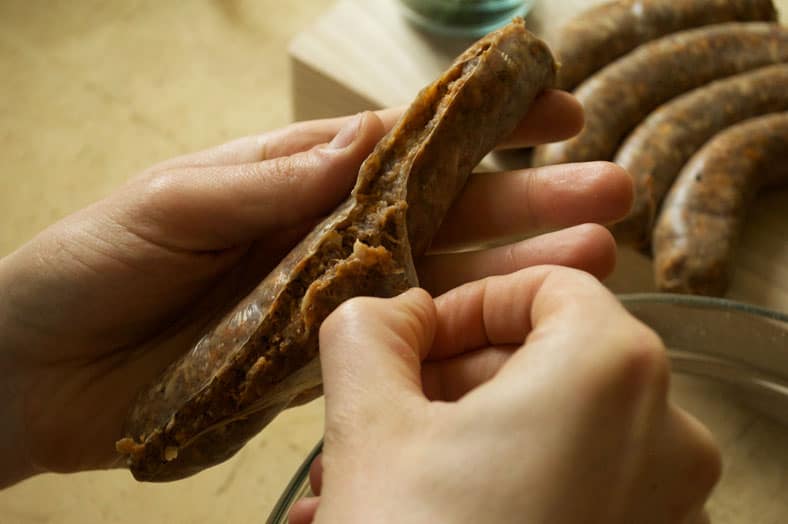
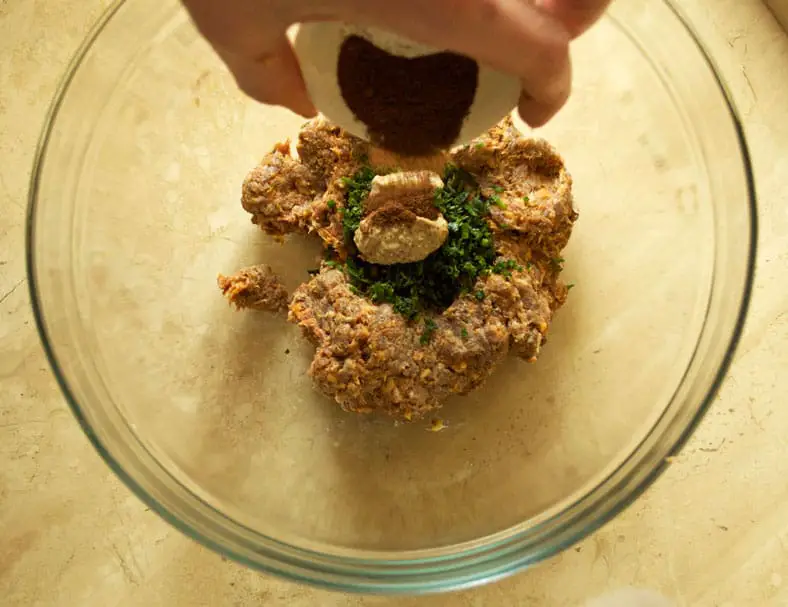
One of the true skills for Scotch eggs comes in finessing pieces of minced meat around a carefully peeled pre-boiled egg. First, you start with a piece of your meat mixture rolled into a ball in your palm. You’ll try to flatten the ball as much as you can and create a small crater to place the egg, which you then do. The trick, then, is to carefully work your way around and flatten – using the pressure of your thumb finger and little else – the meat until it can be lifted and folded over the egg. Once the egg is fully engulfed, pinch all sides together and seal the egg in.


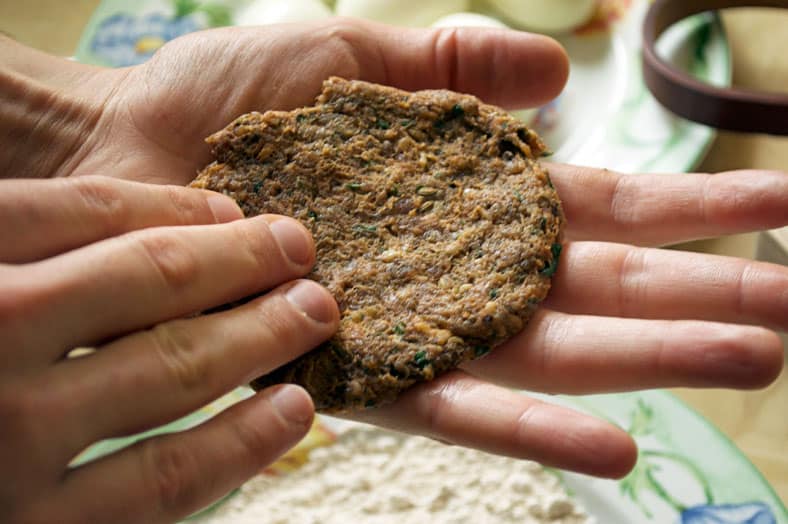
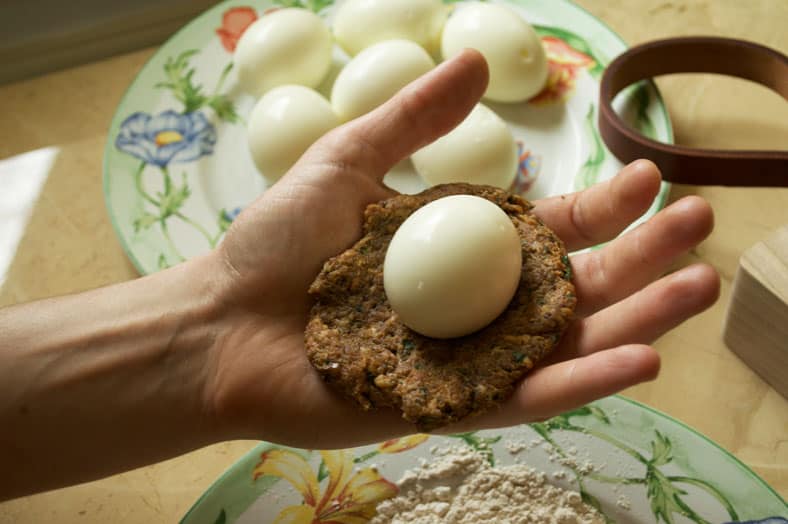
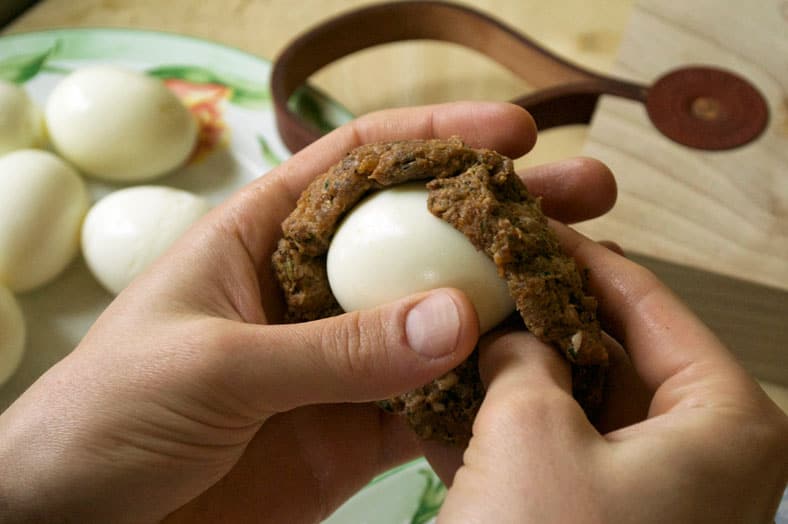
With finely-encased Scotch eggs ready to go, the next step before frying is to dredge and bread your wrapped eggs. Setting up an efficient “assembly line” workstation of flour, beaten eggs and breadcrumbs in that order, you’ll start by lightly dredging your egg-meat-ball in some flour. Be careful not to over-dredge, since you don’t want it to become too thick and dense. From the flour, you lightly dip all sides in the beaten egg and let any excess egg drip off. Finally, roll your wettened Scotch egg in your bread crumbs, and you’re ready to fry!
If you love interesting egg recipes for breakfast you’ll love Tunisian one-pan eggs and tomato in cast iron skillet (shakshouka).

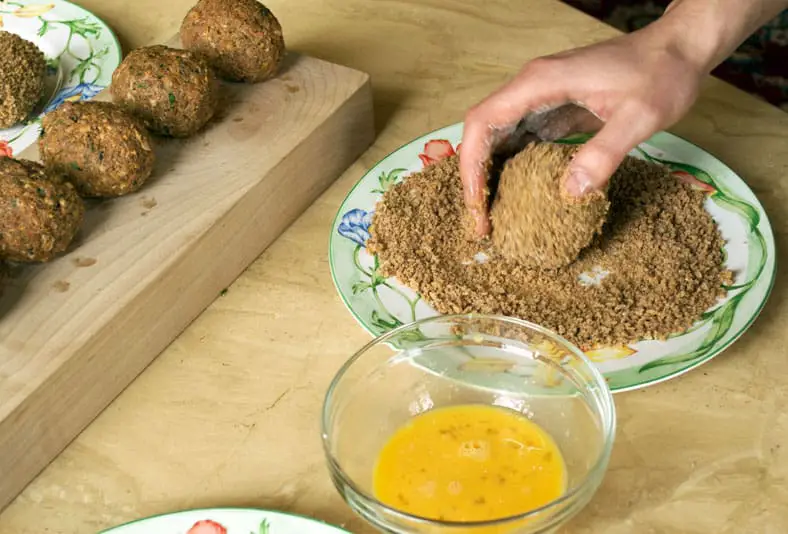
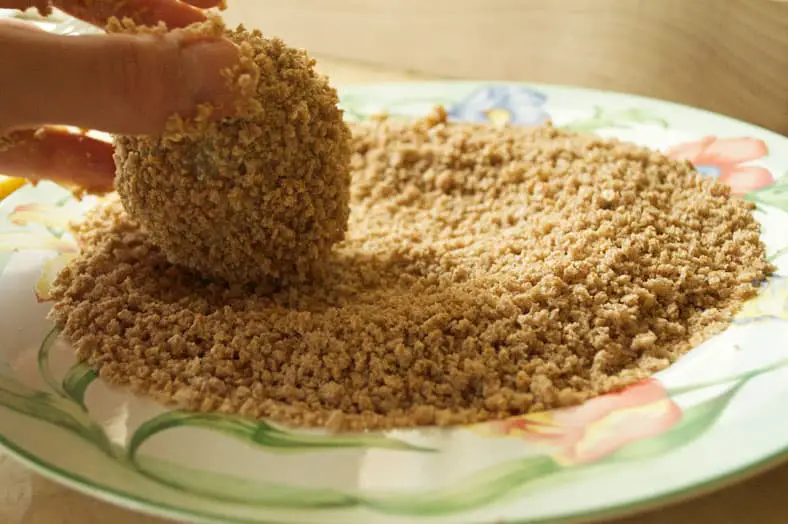
In case you need a walkthrough on how to master the art of creating the pre-fried Scotch egg, this video offers a fantastic step-by-step short tutorial.
The final step, the frying, is truly the easiest part. Simply set a deep enough pan with a high enough level of frying oil, and fry your Scotch egg for several minutes on each side until the breadcrumbs are golden brown and the meat is fully cooked.

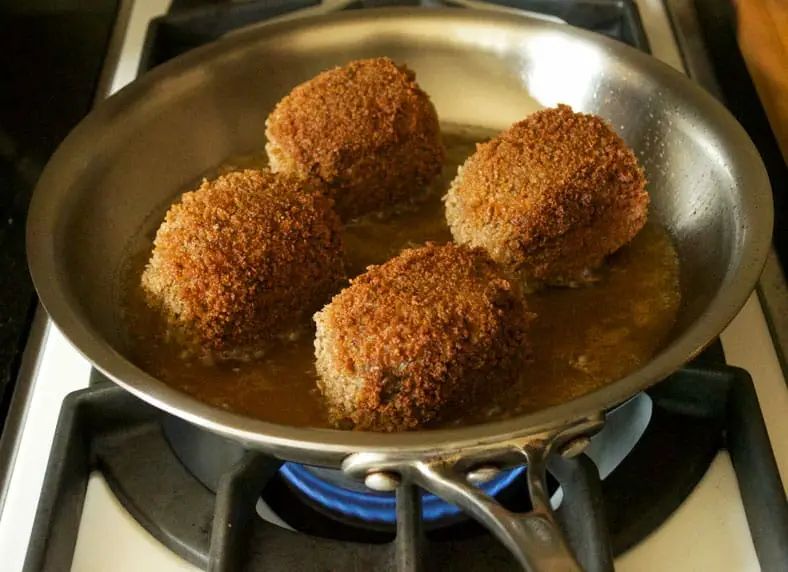


Our Take on the Recipe
Given his expertise on being an Englishman, we felt it more than appropriate to have our original reference recipe be from one of the most recognizable and (for us) well-revered chefs out there, Jamie Oliver. He’s definitely one of our chef’s when it comes to cooking style and overall philosophy on food.
Despite his clear knowledge on what makes a good Scotch egg, we still did make our own adjustments to the recipe.
Perhaps most significantly, we substituted the vegetable oils his recipe suggests for coconut oil instead. It’s a healthier oil to use, and it works beautifully when it comes to frying. And depending on who you ask, there’s an interesting tinge of yummy coconut flavor that’s imparted on the Scotch egg as well, giving it greater depth. We personally didn’t taste that ourselves, but some in our little feedback group did.
For the outer meaty encasing, we went down to our local butcher and picked out some of the finest Italian sausages they had. These sausages already had some flavorings added to them obviously, which was certainly more than welcome for our Scotch eggs, but the quality of the meat in these sausages is really why we did it. When we got home, we extracted the meat and went forth on our Scotch egg-y way.
As a quick aside, the type of egg you’ll use will determine how much meat you’ll need for your Scotch egg recipe. In our case, we used hen’s eggs for our recipe, but you’ll find others using quail’s eggs just as frequently, which understandably reduces your meat requirement.
For the aromatics and other tastes, we swapped out nutmeg for ground cloves in our Scotch eggs. Part of this rationale is rooted more in history: at least in the Elizabethan theory, Scotch eggs were heavily spiced with cloves to help stave off spoilage of the meat and to allow them to last longer. It is a nice bonus that it helps them taste so lovely too, however.
In our dredging and flouring section of the process, we opted for slightly healthier alternatives both with respect to our flour and our breadcrumbs. We used unbleached and unrefined whole wheat flour for dredging as well as minimally-processed (most others are) whole wheat panko breadcrumbs. Not a tremendous health upgrade, mind you, but it’s a slight improvement nonetheless.
Finally, for fresh herbs, we added very finely chopped chives and parsley to the mixture as well. Both offer a nice flavor to brighten the mixture and, well, you can hardly go wrong adding in an extra vibrant herb or two into your recipes.
Other than that, that’s pretty much it! Whether as a snack or even as a full-fledged meal, this food is a delight to have and pairs wonderfully with a nice, hearty aged cheese, some cornichons and, if you’re up for it, a delicious pint of stout.
Enjoy!
What do you add to your Scotch eggs? Comment below!



Scotch Eggs
- Total Time: 35 minutes
- Yield: 3–4 people 1x
Description
Scotch Eggs with fresh parsley, leaves picked and finely chopped.
Ingredients
- 7 large whole eggs
- 1½ pounds sausage meat
- 1 small bunch fresh chives, finely chopped
- 1 small bunch fresh parsley, leaves picked and finely chopped
- 1 small bunch thyme, finely chopped
- 1 tablespoon English mustard
- 1 teaspoon ground cloves
- 1 teaspoon sea salt
- 1 teaspoon ground black pepper
- ⅔ cup whole grain flour (for dredging)
- 2 more eggs, beaten
- ⅔ cup panko breadcrumbs
- 1 cup coconut oil
Instructions
Stage 1 – Soft Boiling the Eggs
- Submerge your whole eggs in a pot of cold water and place over high heat on your stove
- Bring the water to a boil and keep the eggs boiling for 3-4 minutes. Note: if you prefer hard-boiled eggs in your Scotch eggs, then boil your eggs for an additional 6 minutes (10 total)
- After boiling, quickly take your eggs out of the boiling water and submerge in a bowl full of ice water
- Carefully peel your eggs and set aside
Stage 2 – Making the Filling
- Place your sausage meat in a bowl and add your chives, parsley, thyme, mustard, ground cloves. Mix very well together
- Once well mixed, season with your salt and pepper and mix well again
- Once mixed, split your mixture into 7 equal pieces (1 for each egg) and roll into a ball with your hands
Stage 3 – Wrapping the Egg
- Take a ball of your meat mixture in your hands. Flatten the meat in the palm of your hand and create a small crater for the egg to sit
- Place your egg in the middle, then slowly work the meat around the whole egg. Use your thumb to press and further flatten more of the meat to reach the top of the egg, then pinch all the corners of meat together to fully cover the egg
Stage 4 – Dredge and Bread
- Set up a four-part workstation for yourself. Set your meat-wrapped eggs to the left, then a plate of your dredging flour, followed by a bowl with your beaten eggs, and finally a plate of your panko breadcrumbs
- Take a ball and roll lightly through the flour. You only want a light coating, so shake off any excess that isn’t needed once it’s fully coated
- Next, dip the ball into the bowl of beaten eggs. You don’t want to have too much beaten egg covering the mixture, as it might turn the egg soggy once it cooks. Let any excess egg mixture drip off the egg before moving to the breadcrumbs
- Finish your prep of the Scotch egg by rolling it through your panko breadcrumbs. Cover all of the surface area with bread crumbs as best you can, then set aside for cooking
Stage 5 – Frying the Eggs
- In a deep saucepan, add and heat your coconut oil until it fully melts and offers a nice level for frying
- Place your Scotch eggs into the pan and fry each side for 1½ minutes on each side until the breadcrumbs are a beautiful golden brown. You should be able to easily fry all six sides of the egg (including top and bottom), so cooking and frying should take 9 minutes total
- Once done frying, remove your eggs from the oil and place on a plate with a paper towel (to let excess oil drip off)
- Serve with cheese and pickles, and enjoy!
- Prep Time: 20 mins
- Cook Time: 15 mins
- Category: Appetisers
- Cuisine: English
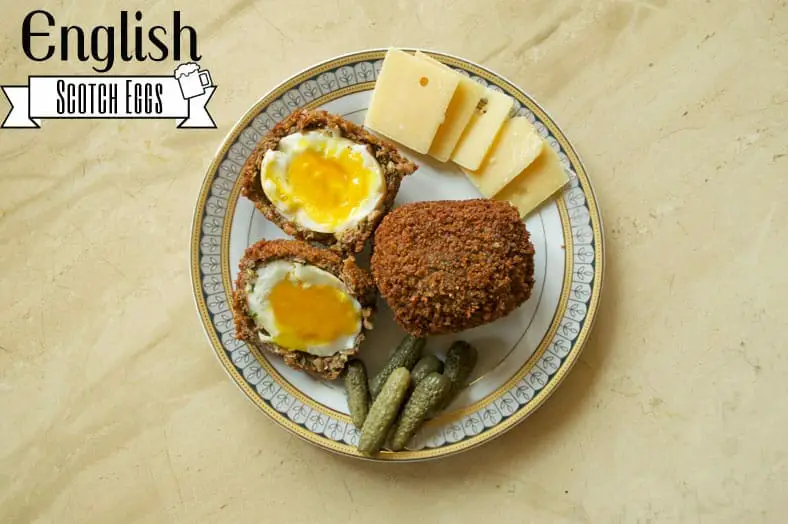

We just had the most amazing brunch of scotch eggs and irish soda bread. Everything worked exactly as you said – i can’t believe how easy the bread is – I am going to make it for guests at the cottage regularly. Loving this blog!!
That’s awesome, Alison, and thanks so much for the support! So great to hear that they worked out just as swimmingly for you. Hopefully your guests like them as well! 🙂
Such a cool history lesson! Scotch Eggs are one of my favorite RennFest treats, they are fantastic!
Thanks Elena! And they are pretty amazing, aren’t they? 🙂
You guys…I swear I get excited with each new post to see where you’re ‘highlighting’ next- I wonder if Iran will make the cut haha (ironically, I have a Persian recipe for Wednesday!). I LOVE scotch eggs, but moreso the crunchy outside and using good quality meat too- Yum!
Arman that’s so awesome to hear, thanks for the super kind words 🙂
We actually just recently did a Sabzi Polo ba Mahi for Nowruz about 1.5 months ago, but we can never say no to more Persian recipes! Are you Persian yourself, or a fan of the food? And we’ll be checking out your recipe for Wednesday undoubtedly!
Always love your step-by-step tutorials! Makes everything look easy to make for sure. I also love that you used coconut oil and cannot agree more that it’s the better oil. Thanks for sharing this delicious dish!
Thanks, Manila Spoon! Yeah.. we’re extremely sold on coconut oil for any scenario really. There’s too many health benefits that can’t be ignored from it 🙂
If you happen to want to make Scotch Eggs down the road, let us know!
As always, love your discussion of the origins (or possible origins) of the recipe. I’ve never made scotch eggs, but I like the concept so I might try it. But I’ll have to disagree on the choice of oils – when I use coconut oil, like your taste-testers, I detect a slight coconutty flavor, which is definitely not what I’d be looking for in a savory dish. With excellent sausage and your step-by-step instructions, I think I’d love the final result.
Thanks Laura! You (and our taste testers) are slightly right with the slight coconutty flavor, which is something we might actually just be used to because of our heavy use of coconut oil.
Either way, let us know if you do end up making these and how it goes! 🙂